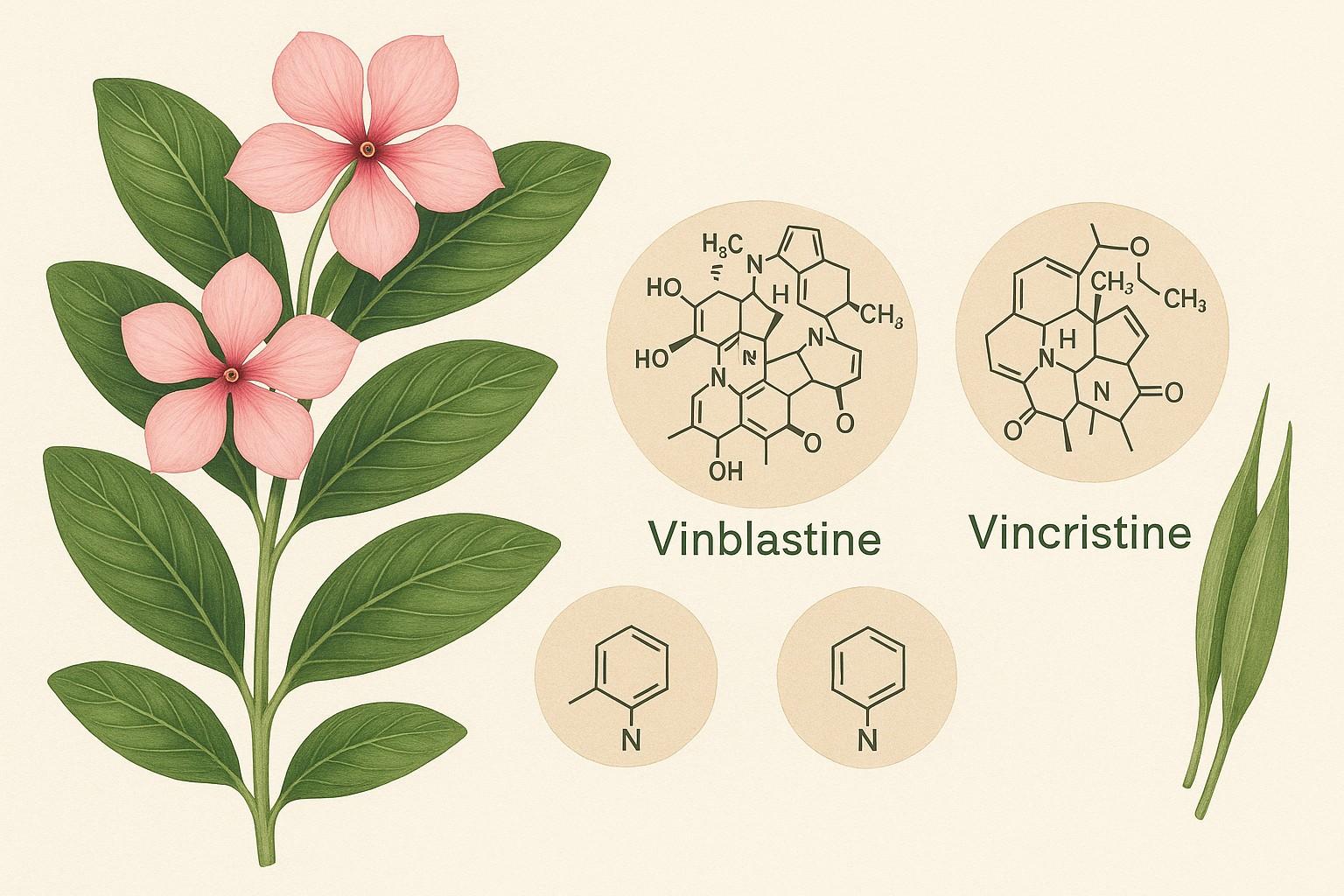Catharanthus roseus, commonly known as the Madagascar periwinkle, is an evergreen plant notable for its oval to oblong leaves, glossy green flowers, and characteristic pair of seed follicles. Renowned for its healing properties, this plant has been extensively studied for its potential in treating a variety of health conditions, including cancer and diabetes.
With around 400 different alkaloids, C. roseus finds applications across multiple industries—medicine, agriculture, food enhancement, fragrance, and pest control. Among its most significant alkaloids are vinblastine and vincristine, both essential in cancer treatment. The plant also contains other potent compounds such as vindesine, vindoline, tabersonine, ajmalicine, serpentine, reserpine, catharanthine, and many more—each contributing unique pharmacological benefits.
Some of these alkaloids, like ajmaline and ajmalicine, are beneficial for cardiovascular health, supporting heart rhythm and reducing blood pressure. Others, such as serpentine and reserpine, are effective in managing hypertension. Alpha-tabersonine and alstonine show potential in managing cancer and diabetes, while apovincamine enhances brain blood flow and memory function. Compounds like conolidine and cryptolepine have analgesic, anti-inflammatory, and antimalarial effects. Several others, such as eburnamine, ibogaine, and isovincoside, offer neuroprotective, anti-addictive, and cancer-fighting capabilities.
The rising demand for these therapeutic compounds has led to innovative production methods. One such technique is polysaccharide radiolysis, where high-energy radiation is used to treat polysaccharides like carrageenan and sodium alginate, promoting plant growth and increasing alkaloid yield. Non-radiation methods include the use of κ-carrageenan, chitooligosaccharides, and UV-B light. These methods enhance alkaloid content and antioxidant activity, with suspension cultures often showing two to three times higher yields than traditional agar cultures. Interestingly, the highest levels of vinblastine are found in leaf-derived calluses, while roots show no such production.
Vinblastine and vincristine have shown remarkable efficacy against cancers like Hodgkin’s lymphoma and leukemia. Vinblastine disrupts microtubule formation, halting cell division, while vincristine interferes with chromosome separation during mitosis. These mechanisms lead to the arrest of the cancer cell cycle, modulation of cyclin B, and eventual cell death.
Further, these alkaloids influence key cellular signaling pathways. They activate the JNK pathway, which governs apoptosis and stress responses. This process promotes mitochondrial changes that lead to programmed cell death. Other compounds can also stimulate JNK activation by triggering upstream proteins like MKK7 and MKK4. Such mechanisms are observed in cancer treatments involving vincristine.
The NF-κB pathway, a major regulator of inflammation, cell survival, and gene expression, is another target of vinca alkaloids. These compounds degrade IκBα, allowing NF-κB to enter the nucleus and activate genes involved in cancer progression. Modulating this pathway is vital in developing new cancer therapies. However, glucocorticoids can counteract this activation, reducing the effectiveness of vinca alkaloids in some cases.
MicroRNAs (miRNAs), small non-coding RNA molecules, also play a pivotal role in cancer regulation. Vinca alkaloids influence miRNA expression, increasing sensitivity to chemotherapy and suppressing tumor growth. For example, vincristine boosts miR-155 expression in resistant lymphoma cells and miR-122 in various tumors, both of which enhance the therapeutic impact. Other miRNAs, like miR-1179, can inhibit cancer-related pathways such as PI3K/AKT and MEK/ERK, improving treatment outcomes.
Despite their benefits, vinca alkaloids come with significant side effects. As a result, researchers have developed novel drug delivery systems to reduce toxicity and enhance effectiveness. These include nanodiamonds, polymeric nanoparticles, liposomes, and magnetic carriers. Encapsulation and targeted delivery techniques improve the bioavailability and minimize side effects of drugs like vinblastine and vincristine.
Traditionally, various parts of C. roseus have been used to treat conditions such as diabetes, stomach ailments, infections, hypertension, dysentery, and cancer. Extraction methods like maceration, Soxhlet extraction, ultrasound-assisted extraction, and supercritical fluid extraction are employed to isolate bioactive compounds. After extraction, purification is done through chromatographic techniques, and identification is carried out using mass spectrometry, NMR, and IR spectroscopy.
Apart from alkaloids, the plant contains phenolic compounds such as caffeoylquinic acids, quercetin, kaempferol, and isorhamnetin. These offer additional antioxidant, anti-inflammatory, and anticancer benefits. Extracting these substances involves careful selection of plant parts and advanced techniques like ultrasound-assisted and hot water extraction.
In traditional Chinese medicine, C. roseus is used to treat inflammation, improve kidney function, relieve respiratory issues, and address various cancers. With the global burden of cancer on the rise, this plant stands out as a promising natural resource in the development of future therapeutics.
Among its most celebrated alkaloids are vinblastine, vincristine, vindesine, and vinorelbine, each known for their potent anticancer properties. Traditional medicinal practices and modern scientific research continue to highlight Catharanthus roseus as a vital botanical ally in combating serious health conditions.
– Dr. Arun Kumar Kulshrestha, (Ph.D., CSIR-UGC NET)
Faculty of Basic and Applied Sciences, Madhav University

